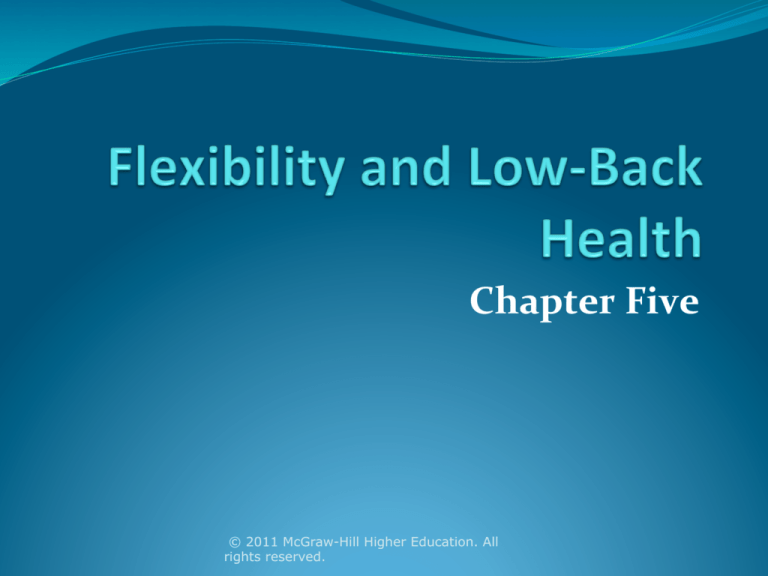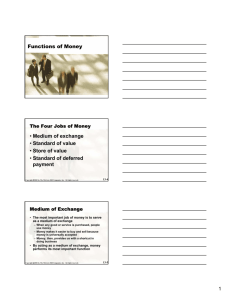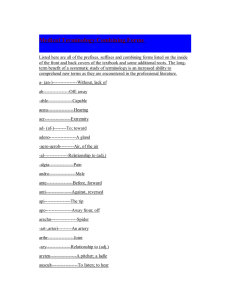
Chapter Five © 2011 McGraw-Hill Higher Education. All
rights reserved.
What Is Flexibility? Flexibility is the ability of a joint to move through its normal range of motion It is a highly adaptable fitness component and responds well when utilized as part of a fitness program Flexibility is joint specific, meaning that you must work all major joints, not just a few © 2011 McGraw-Hill Higher Education. All
rights reserved.
2
Types of Flexibility There are two types of flexibility Static Flexibility: ability to hold an extended position at one end in a joint’s range of motion
Dependent on your ability to tolerate stretched muscles, joint structure, and tightness of connective tissues Most assessment tests are based on this type Dynamic Flexibility: ability to move a joint through its range of motion with little resistance
Important for daily activities and sports © 2011 McGraw-Hill Higher Education. All
rights reserved.
3
What Determines Flexibility? The flexibility of a joint is affected by the following: Joint Structure (cannot be changed)
Hinge joint Ball and socket Heredity plays a part in joint structure and flexibility Muscle Elasticity and Length
Collagen Elastin Elastic elongation Plastic elongation The Nervous System
Proprioceptors Proprioceptive neuromuscular facilitation © 2011 McGraw-Hill Higher Education. All
rights reserved.
4
Basic Joint Structure Figure 5.1
© 2011 McGraw-Hill Higher Education. All
rights reserved.
5
Benefits of Flexibility Joint health Prevention of low-­‐back pain and injuries Relief of aches and pains Relief of muscle cramps Improved body position and strength for sports Maintenance of good posture and balance Relaxation © 2011 McGraw-Hill Higher Education. All
rights reserved.
6
Crea?ng a Successful Program Safe exercises executed with most effective techniques Goal should be to attain normal flexibility in the major joints You achieve balanced flexibility by performing stretching exercises regularly and by using a variety of stretches and stretching techniques © 2011 McGraw-Hill Higher Education. All
rights reserved.
7
Applying the FITT Principle to Develop Flexibility Frequency: 2-­‐3 days per week (minimum) Intensity: Stretch to the point of mild discomfort, not pain Time: Hold stretches for 15-­‐30 seconds and perform 2-­‐4 times Type: Stretching exercise that focus on major joints © 2011 McGraw-Hill Higher Education. All
rights reserved.
8
Figure 5.2 The FITT Principle for a Flexibility Program © 2011 McGraw-Hill Higher Education. All
rights reserved.
9
Types of Stretching Techniques Static Stretching Proprioceptive Neuromuscular Facilitation (PNF) © 2011 McGraw-Hill Higher Education. All
rights reserved.
10
Managing Low-­‐Back Pain More than 85% of Americans experience back pain at some time in their lives Low-­‐back pain is the second most common ailment in the United States, headaches being number one Estimated cost is $50 billion a year Back pain can result from sudden traumatic injuries, but is more often the result of: Weak and inflexible muscles Poor posture Poor body mechanics during activities © 2011 McGraw-Hill Higher Education. All
rights reserved.
11
Muscle imbalances Due to overuse of some muscles ( anterior when swimming or pitching) Can cause rotator cuff problems, back pain Ways to overcome this – exercise opposing muscle groups © 2011 McGraw-Hill Higher Education. All
rights reserved.
12
Excessive Spinal curvatures Kyphosis-­‐ excessive thoracic curvature Lordosis-­‐ excessive lumbar curvature Scoliosis-­‐ excessive lateral curvature Causes of : Kyphosis swimming ( esp breastroke, butterfly, freestyle) Lordosis: tight quads after exercise Scoliosis: holding a backpack on one side all the time. Ways to prevent: Kyphosis backstroke Lordosis: crunches and stretching, Scoliosischeck holding techniques, leg length differences. © 2011 McGraw-Hill Higher Education. All
rights reserved.
13
Func?on/Structure of the Spine Provides structural support for the body Surrounds and protects the spinal cord Supports body weight Serves as attachment site for muscles, tendons, ligaments Allows movement of neck and back in all directions © 2011 McGraw-Hill Higher Education. All
rights reserved.
14
The Spinal Column © 2011 McGraw-Hill Higher Education. All
rights reserved.
15
Figure 5.4 Vertebrae and an Intervertebral Disk © 2011 McGraw-Hill Higher Education. All
rights reserved.
16
Core Muscle Fitness Core muscles include those in the abdomen, pelvic floor, sides of the trunk, back, buttocks, hip, and pelvis There are 29 muscles attaching to the ribs, hips, spinal column, and other bones in the trunk of the body Core muscles stabilize the spine and help transfer force between the upper body and lower body Lack of core muscle fitness can create an unstable spine and stress muscles and joints Whole body exercises and exercises using free weights or stability balls all build core muscle fitness © 2011 McGraw-Hill Higher Education. All rights reserved.
17
Causes of Back Pain Back pain can occur at any point along your spine Any excessive stress upon the spinal column can cause injury and pain Risk factors: Degenerative diseases (arthritis or osteoporosis) Family or personal history Sedentary lifestyle Underlying causes of back pain include:
Poor muscle endurance and strength Excessive body weight Poor posture or body position at rest Poor posture body mechanics during activity Previous injuries © 2011 McGraw-Hill Higher Education. All
rights reserved.
18
Preven?ng Low-­‐Back Pain Maintain a healthy weight Stop smoking Reduce stress Avoid sitting, standing, or working in the same position for too long Use a supportive seat and a medium-­‐firm mattress Warm up thoroughly before exercising Progress gradually when improving strength and fitness © 2011 McGraw-Hill Higher Education. All
rights reserved.
19
Managing Acute Back Pain Symptoms: Pain Muscle spasms Stiffness Inflammation Treatment Apply heat or cold Over-­‐the-­‐counter anti-­‐inflammatory medication (ibuprofen or naproxen) Gentle flexibility Bed rest See physician if pain doesn't resolve within a short time © 2011 McGraw-Hill Higher Education. All
rights reserved.
20
Protec?ng Y
our B
ack An exercise program designed to increase flexibility and
strengthen the legs, abdomen, and lower back can help
prevent low-back pain.
When sleeping:
• Lie on your side with your knees and hips bent. If you lie on
your back, place a pillow under your knees.
When sitting:
• Sit with your lower back slightly rounded, knees bent and feet
flat on the floor. Alternate crossing your legs or use a footrest to
keep your knees higher than your hips.
© 2011 McGraw-Hill Higher Education. All
rights reserved.
21
Protec?ng Your Back (cont.) When standing:
• Keep your weight mainly on your heels, with one or both knees
slightly bent. Try to keep your lower back flat (not arched) by
placing one foot on a stool.
When walking:
• Keep your toes pointed straight ahead, your back flat, head up
and chin in.
When lifting:
• Bend at the knees and hips rather than at the waist and lift
gradually using your leg muscles.
© 2011 McGraw-Hill Higher Education. All
rights reserved.
22
Exercises for the Preven?on and Management of Low-­‐Back Pain Do low-­‐back exercises at least 3 days per week Emphasize muscular endurance Do not do full range of motion spine exercises early in the morning Engage in regular endurance exercise Be patient and stick with your program © 2011 McGraw-Hill Higher Education. All
rights reserved.
23
Chapter Five © 2011 McGraw-Hill Higher Education. All
rights reserved.







